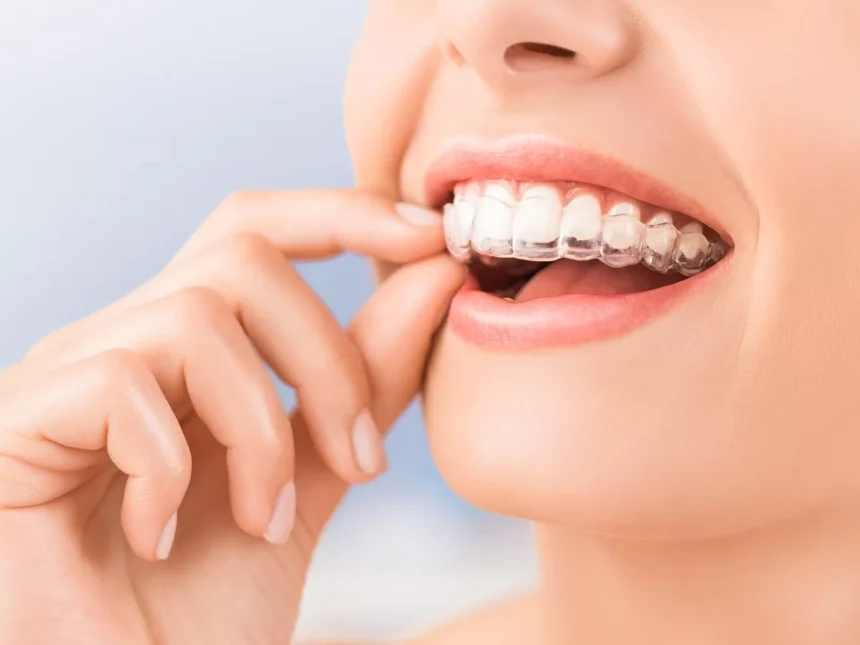Many people choose Invisalign to get a straighter smile, but what about its other effects? A common question we hear is whether this popular orthodontic treatment can actually alter your face shape.
The idea that moving your teeth could change your facial structure isn’t so far-fetched. After all, your teeth and jaw provide the underlying support for your lower face. Any significant changes in this area could reasonably lead to visible differences in your appearance.
This article will explore the connection between Invisalign and facial changes. We will look at how different orthodontic issues can affect your appearance and what you can realistically expect from Invisalign treatment. By the end, you’ll have a clear, dentist-approved understanding of how straightening your teeth might enhance your overall facial profile.
How Your Teeth Influence Your Face Shape
Before we discuss Invisalign specifically, it’s important to understand the role your teeth and jaw play in shaping your face. The position of your jaw, the alignment of your teeth, and the way your upper and lower arches meet all contribute to the structure of your lower face, including your lips, cheeks, and chin.
When teeth are misaligned, this can sometimes lead to noticeable facial asymmetries. For example:
- Protruding Teeth: Teeth that stick out can push the lips forward, creating a fuller, sometimes strained appearance.
- Recessed Jaw: A lower jaw that sits too far back can create the appearance of a “weak” chin and a less defined jawline.
- Facial Asymmetry: Misaligned jaws or teeth can cause one side of the face to look different from the other, impacting the balance of your features.
By correcting these underlying dental issues, orthodontic treatments like Invisalign have the potential to create subtle yet positive changes in your facial aesthetics.
How Invisalign Can Affect Your Facial Appearance
Invisalign works by gradually moving your teeth into their correct positions using a series of custom-made, clear aligners. While its primary goal is to improve your smile and bite, these changes can sometimes lead to secondary shifts in your facial features. The extent of these changes largely depends on the specific orthodontic issue being treated.
Correcting an Overbite
An overbite is when your upper front teeth significantly overlap your lower front teeth. In severe cases, this can cause the upper lip to protrude and the chin to appear recessed or weak.
Invisalign can correct an overbite by gradually moving the upper teeth back and, if necessary, encouraging forward movement of the lower jaw. As the bite is corrected, you may notice:
- A more balanced and harmonious facial profile.
- A less prominent upper lip.
- A stronger, more defined chin and jawline.
These changes help create a more proportioned look, enhancing the overall symmetry of your face.
Fixing an Underbite
An underbite occurs when the lower teeth sit in front of the upper teeth. This can cause the lower jaw and chin to jut forward, creating a “bulldog-like” appearance that can make the face look imbalanced.
By realigning the teeth and correcting the bite, Invisalign can help reduce the prominence of the lower jaw. This often results in:
- A softer, more natural facial contour.
- A less prominent chin.
- Improved facial symmetry.
For many patients, correcting an underbite with Invisalign brings the lower third of their face into better harmony with their other features.
Addressing an Open Bite
An open bite is when the upper and lower front teeth don’t touch when the mouth is closed. This can be caused by habits like thumb-sucking or tongue-thrusting. An open bite can make it difficult to close the lips naturally, sometimes giving the face an elongated appearance.
Invisalign can close an open bite by moving the upper and lower teeth into proper alignment so they meet correctly. This can lead to:
- The ability to close your lips comfortably without straining.
- A shorter, more balanced facial appearance.
- A more relaxed and natural look around the mouth.
Correcting an open bite often has a significant and positive impact on the patient’s facial profile.
Fixing a Crossbite
A crossbite happens when some of your upper teeth sit inside your lower teeth when you bite down. This misalignment can lead to uneven jaw growth and noticeable facial asymmetry. One side of the jaw may appear fuller or more developed than the other.
Invisalign can correct a crossbite by expanding the upper arch and moving the teeth into their proper positions. As the bite is corrected, you might see:
- Improved facial symmetry and balance.
- A more even appearance in the cheeks and jawline.
- Reduced strain on the jaw muscles.
By resolving the underlying dental issue, Invisalign can help restore a more symmetrical and harmonious look to your face.
Will I Look Like a Different Person?
It’s important to have realistic expectations. While Invisalign can lead to noticeable improvements in your facial profile, the changes are usually subtle. You will still look like yourself—just a more balanced and refined version.
Think of it as fine-tuning rather than a complete overhaul. The goal of orthodontic treatment is to create a healthy bite and a beautiful smile. The resulting facial enhancements are a fantastic bonus. The most significant changes are typically seen in patients who start with more severe bite issues, such as a pronounced overbite or underbite. For those with minor crowding or spacing, facial changes may be minimal or not noticeable at all.
Factors That Influence Facial Changes
Not everyone who uses Invisalign will experience a change in their face shape. Several factors can influence whether you’ll see a difference:
- Age: Younger patients whose jaws are still developing may experience more noticeable changes than adults whose facial bones are fully formed.
- Severity of Misalignment: The more severe your bite problem, the more likely you are to see a change in your facial profile after treatment.
- Treatment Plan: The specifics of your Invisalign plan, such as whether it involves extractions or the use of rubber bands, can also play a role. Your dentist will design a plan tailored to your specific needs, and they can give you an idea of what to expect.
Unlock Your Best Smile and Profile
So, can Invisalign change your face shape? The answer is yes, it can—in a positive and often subtle way. By correcting underlying bite issues, Invisalign helps create a more harmonious and balanced facial profile. While you shouldn’t expect a dramatic transformation, the adjustments to your teeth and jaw can enhance your natural features, leading to a more confident you.
If you are considering Invisalign and are curious about how it might affect your appearance, the best first step is to consult with an experienced dentist. They can assess your specific situation, discuss your aesthetic goals, and provide a clear picture of what you can achieve with treatment.
Ready to explore how Invisalign can improve both your smile and your facial symmetry? Schedule a consultation today to learn more and start your journey toward a healthier, more confident smile.









